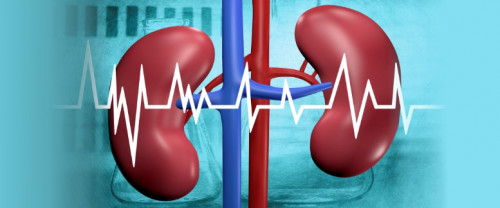Chronic kidney disease (CKD) is a pathological condition that gradually impairs kidney function over a long period of time. Early detection of CKD is crucial in preventing disease progression and reducing the risk of serious complications. One of the methods used in the early detection of CKD is the examination of microalbumin, creatinine, and the albumin-creatinine ratio. In this article, we discuss the importance of these examinations as diagnostic tools for early detection of CKD.
Microalbumin is a small form of albumin that is usually undetectable in healthy urine. However, when the kidneys experience early damage, microalbumin can leak into the urine. Therefore, testing for microalbumin in urine can provide early indications of kidney damage. A commonly used method is the urine microalbumin-creatinine ratio (UACR) test, which measures the concentrations of microalbumin and creatinine in urine. High results on the UACR test indicate the presence of albuminuria, which is the presence of albumin in urine and a sign of kidney damage.
In addition, blood creatinine levels are also used as an important indicator to evaluate kidney function. Creatinine is a byproduct of muscle metabolism that is produced and excreted by the kidneys. Healthy kidneys will regularly eliminate creatinine. However, if the kidneys are damaged, their ability to excrete creatinine will be impaired, leading to increased levels of creatinine in the blood. Therefore, testing for blood creatinine levels can help detect kidney damage.
Furthermore, the albumin-creatinine ratio in urine is also used as an indicator of CKD. Albumin is a protein produced by the liver that is typically filtered by the kidneys and returned to the blood. However, if the kidneys are damaged, albumin can leak into the urine. By measuring the albumin-creatinine ratio in urine, it can be determined whether the kidneys are functioning properly or not. A high albumin-creatinine ratio indicates the presence of albuminuria and may be a sign of kidney damage.
Based on research and studies conducted, testing for microalbumin, creatinine, and the albumin-creatinine ratio has been proven effective in the early detection of CKD. A study published in the Journal of the American Medical Association showed that the UACR test has good sensitivity and specificity in detecting early kidney damage, even before clinical symptoms of CKD appear. This finding suggests that using this test can allow for early intervention to prevent disease progression and reduce the risk of serious complications associated with CKD.
In another study published in the journal Nature Reviews Nephrology, a relationship was found between urine albumin levels, creatinine, and risk factors such as diabetes and hypertension. This study highlights the importance of routine testing for microalbumin, creatinine, and the albumin-creatinine ratio in patients with these risk factors for early detection of CKD.
Detection of Chronic Kidney Disease:
Early detection is crucial in identifying potential risks before the disease progresses. It plays a significant role in preventing and minimizing the occurrence of chronic kidney disease. The detection process for CKD involves three essential components:
- Blood pressure measurement.
- Blood test to measure serum creatinine and eGFR (estimated glomerular filtration rate).
- Urine test to assess the albumin-to-creatinine ratio (ACR).
In individuals with or without diabetes, it is recommended to measure albuminuria using a first morning urine sample. However, temporary increases in ACR can be caused by factors like diurnal variations in protein excretion, urinary tract infections, fluid overload, or acute febrile illnesses. Therefore, an elevated urine ACR should be confirmed through repeated measurements.
Similarly, a diagnosis of CKD is confirmed by having at least three eGFR measurements, taken over a period of at least three months. If there is a rapid decline in eGFR, it could indicate acute kidney injury and should be repeated within 14 days. Most patients in the early stages of CKD (stages 1-3) will not progress to end-stage kidney disease requiring renal replacement therapy like dialysis or transplantation. These patients can be primarily managed in general practice. The assessment and management of CKD should be based on the specific stage, as outlined in the table.
The process of screening tests for CKD often comes with a high cost. However, with the PABA-1000 ACR Analyzer, there is a single reagent that can measure three kidney function parameters simultaneously: microalbumin (mAlb), urine creatinine, and the albumin-creatinine ratio (ACR). This helps make the overall cost of the examination more affordable and efficient.
PT Isotekindo Intertama is an official authorized distributor registered with the Ministry of Health for PABA-1000 ACR Analyzer products manufactured by Changsha Sinocare Inc. The ACR Monitoring System consists of the PABA-1000 ACR Analyzer, mALB/Cr Reagent Kit, and control solution (level 1, level 2). The mALB/Cr Reagent Kit is designed to be used with the PABA-1000 ACR Analyzer to accurately measure microalbuminuria, creatinine, and the ACR (microalbuminuria/creatinine ratio) in urine samples. This system serves as an aid in the diagnosis of renal failure disease.
Here are the features and benefits you will get when using the PABA-1000 ACR Analyzer:
-
Dimensions and weight: 380 x 240 x 254 mm, <6.5 kg. The instrument is compact and lightweight, making it suitable for small labs with limited space.
-
1 reagent type for 3 parameters: microalbumin (mAlb), urine creatinine, and albumin-creatinine ratio (ACR). Using only one reagent reduces the total cost of the examination.
-
Connectivity: It can be connected to external instruments and systems through One RS232, USB, RJ45, and LIS interfaces. This ensures data security and meets audit and accreditation requirements.
-
Storage capacity: It can store up to 2000 tests, allowing for easy access to patients' medical records and meeting quality control requirements.
-
Short measurement time: Less than 6.8 minutes. The fast detection time helps meet customer satisfaction and institutions' target time for delivering results.
-
Detection technology: It uses colorimetric and fluorescence systems. The advanced technology ensures reliable results in diagnostic and monitoring tests related to kidney function, comparable to conventional testing methods.
-
Sample type: Urine samples (fresh urine, 24-hour urine) can be used. This makes sampling easier and more convenient.
By utilizing the PABA-1000 ACR Analyzer, users can benefit from its compact design, cost-effectiveness, connectivity options, large storage capacity, fast measurement time, advanced detection technology, and ease of sample collection.
In conclusion, early detection of chronic kidney disease is an important step in preventing disease progression and improving patient prognosis. Testing for microalbumin, creatinine, and the albumin-creatinine ratio is an effective method for detecting kidney damage at an early stage. These tests can be easily conducted and are relatively inexpensive, making them important diagnostic tools in clinical practice. With early detection and appropriate intervention, chronic kidney damage can be better controlled, allowing patients to live a better quality of life.
References:
- American Diabetes Association. (2019). Standards of Medical Care in Diabetes - 2019. Diabetes Care, 42(Supplement 1), S13–S28.
- Levey, A. S., Stevens, L. A., Schmid, C. H., Zhang, Y. L., Castro, A. F., Feldman, H. I., Kusek, J. W., Eggers, P., Van Lente, F., Greene, T., & Coresh, J. (2009). A New Equation to Estimate Glomerular Filtration Rate. Annals of Internal Medicine, 150(9), 604.
- National Kidney Foundation. (2021). Chronic Kidney Disease. Retrieved from https://www.kidney.org/atoz/content/about-chronic-kidney-disease.
- Tangri, N., Stevens, L. A., Griffith, J., Tighiouart, H., Djurdjev, O., & Naimark, D. (2011). A predictive model for progression of chronic kidney disease to kidney failure. JAMA, 305(15), 1553-1559.







